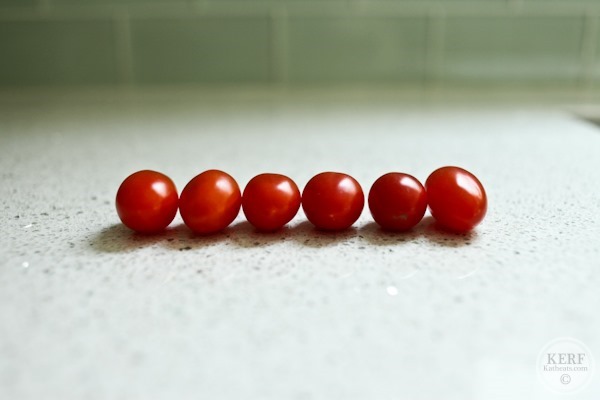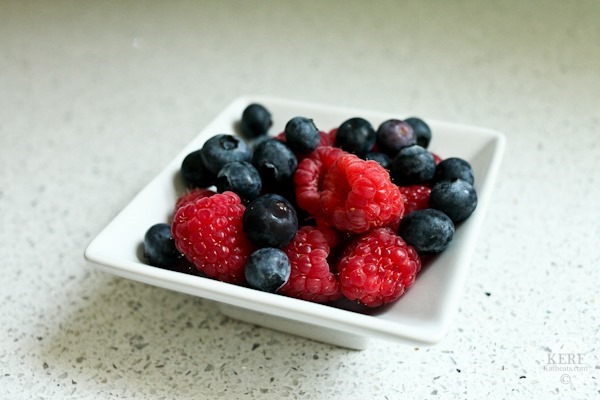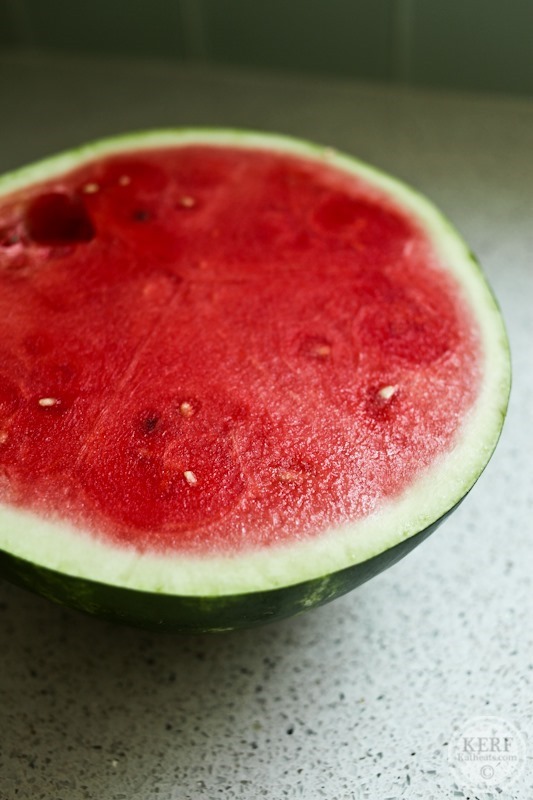This post is sponsored
Remember back when I hosted a survey about ingredients and natural food dyes? The results are in to share! I found the data fascinating because it gave me a glimpse into your heads. While I realize this is a select slice of my opt-in audience, it’s still cool to see what you think.
You guys already know that I’m big on ingredient lists – could you make it in your kitchen if you had the time, energy and basic equipment? This survey was focused on food dyes. Blue #4? What’s that made of? I have no idea. But if you had a beet, grape skins or turmeric, you could probably grind them up and color a bowl of yogurt pink, purple or yellow (after milking the cow and making the yogurt first of course : ) ) If food scientists can create all these crazy synthetic ingredients, then I am sure they have the creativity to do more with real food.
KERF Survey Background Information
The results from KERF are compared to the larger survey that went out to U.S. moms.
o KERF readership is mostly women. 99% of survey takers on KERF were women. I’m not surprised!
o KERF readers are relatively young. 74% of you are under 35 years old, compared to 45% of U.S. moms. This also doesn’t surprise me since I am under 35 myself : )
o Presence and number of children varies among KERF readers. 61% of you do not have kids. 21% have one, 13% have two and 4% have three.
o KERF readers are likely to be married. 61% of you are married. Wedding bells!
o KERF readers are much more likely to have higher degrees. Only 3% of you did not attend any college (compared to 21% U.S. moms), with 46% having 4-year degrees (28% U.S. moms) and 41% with Master’s degrees or greater (11% U.S. moms).
o KERF readers are more likely to work. 68% of you work full time, compared to 39% of U.S. moms. Similarly, 11% of you are full time homemakers, compared to 31% of the U.S. population. Perhaps this is a reflection of the ability to check in on a blog at work? : )
Foodie Results
You guys care deeply about the foods you eat.
This comes as no surprise to me!
-87% of KERF readers are extremely or very invested in knowing the ingredients in the foods they eat (compared to 69% U.S. moms).
-Similarly, 86% of KERF readers read food labels before purchasing a product most of the time or always (63% U.S. moms).
-In line with this, when inquiring whether a product contains naturally derived colors, 92% of KERF readers check the food label (78% U.S. moms).
Unsurprisingly, you all strongly prefer to consume naturally derived ingredients.
–96% feel better knowing your food contains naturally derived ingredients, and 76% feel safer when your kids eat these foods. I think this goes back to the whole “better be safe than sorry” mentality. Why take a risk with ingredients you aren’t sure about if you can choose something with a shorter and more natural ingredient list.
-93% of KERF readers wish U.S. food companies would offer more naturally derived food options, which is in line with the average American mom (83%). (But really, who wouldn’t want their food to be more natural? The best solution is to just eat real food!)
Both KERF readers and the average American mom have positive feelings about naturally derived colors.
-87% of you want the colors of nature reflected in their food (66% U.S. moms)
-83% are willing to spend more on a product containing naturally derived colors instead of synthetics (61% U.S. moms)
-90% are more likely to purchase a food product containing naturally derived colors even if it is less colorful that a similar product containing synthetics (72% U.S. moms). This drives me crazy – why would we need food be colored just for the sake of looks? Dyes in children’s medicine is a good example of this. Mazen doesn’t need his Tylenol to be pink! In fact, I’d rather have it be clear in case it spills, which is does often : )
Your positive feelings toward naturally derived colors have affected behavior.
-Compared to 10 years ago, 76% of you are more likely to buy food containing naturally derived colors (57% U.S. moms). It’s also more available than ever, so this is probably a reflection of that.
-In addition, 83% of you have sought information about food ingredients from sources like manufacturers, regulators, the Internet and friends. (Hello blogs!)
-Of these, 91% read an article about naturally derived foods, 79% watched a news segment about food and 76% conducted a Google search about naturally derived foods.
It is clear to me that you guys are a real-food aware group, and I really appreciate that! It’s interesting to compare you to the sampling of U.S. moms as well – you’re a smart and caring bunch. I stumbled upon this article that suggests the whole nation is caring more about their foods, and that’s great news to hear. Thanks for taking the time to participate in and read this post!






Anele @ Success Along the Weigh says
I love number crunching and to see how I fall with the majority…I’m rarely in it! LOL
Kate says
I thought the most surprising question on the survey was “are willing to spend more on a product containing naturally derived colors instead of synthetics.” Why would I be willing to pay MORE for a company to leave OUT artificial coloring?
KathEats says
17 and 39%… which I find even more interesting!
Ellie says
Hi,
This might be just a cultural difference, given that I’m a UK reader, but if I was one of the 3% of respondents who didn’t go on to college or uni education, I’d be pretty hurt by the way that information was presented. It implied that that 3% is uneducated (which I’m sure you’ll agree is quite a pejorative term, even if it wasn’t intended that way), and not smart, which I’m sure you’ll also agree isn’t defined in terms of how much formal education you received. So sorry to be nit-picky, I’m not usually that sort of person, but the language is slightly crushing to a fair few of your readers. Not a hater, promise!
KathEats says
I thought about this Ellie and changed the way it was worded. You’re right, and the last thing I want to do is offend anyone with my phrasing.
Ellie says
Thanks for replying and considering. Love your blog, have a great day ????
Ellie says
*!!!
Annie says
I’m a numbers gal and a foodie, so I loved reading this! Definitely want to see more natural ingredients in my grocery stores
Ali says
Can you talk about who sponsored this now? I didn’t feel comfortable completing the survey because I didn’t know who sponsored it. Also, it seems weird to compare a big survery of moms to a small survey of blog readers – it’s apples and oranges, especially since 61% of your readers are not moms. Also, I agree with the above commenter that not attending higher education does not mean you are not smart! Education does not equal smart or better than others. I have a MS and am working on my PhD and I would say that I know more people with just a high school education that are smarter than those in my program. I think this survey has a lot of potential, just needs to be formalized a bit more! Sorry – I’m a total numbers junky! 🙂
KathEats says
No I still don’t know. The point of it was just to create conversation around interest in ingredients and dyes, and we used the survey to start that conversation.
Shannon says
Hi Kath, can you clarify what you mean when you say “No I still don’t know”? You stated that at the top of the post that this is a sponsored post – who is sponsoring it? Is it a case that you know the sponsor but they haven’t revealed the company they work with who is requesting the research? I am sure you could share who the sponsor at least was – right?
KathEats says
The sponsor was a PR firm representing a client. I’m not sure who the client is.
kealy says
The math teacher in me had to point out that you cannot compare KERF readers to US Moms because more than half of your readers (61%) are not moms.
KathEats says
This isn’t apples to apples…just info to share
Sheilagh says
Hi kath, are you able to reveal who commissioned the survey & why. Also wondering why they were interested in a subset of the population (kerf readers), especially when it was open to international residents who may live in countries with different regulations regarding food dyes. Not trying to be a hater, but still confused by why this study doesn’t reveal who they are. I chose not to participate in case it was a company I don’t agree with, such as McDonald’s or so that I don’t become part of an advertising campaign for highly processed foods. Thanks & I do love your blog!
KathEats says
This was just to create conversion about ingredient lit’s and natural foods dyes. It seems people are more into the survey logistics than talking about the topic itself. I shared the US moms data along with KERF’s just to provide more grounds for discussion.
Shannon says
I think the topic is really interesting and becoming increasingly important so its nice to see a conversation about it. It is overwhelming for me at times to balance, organic – local – unprocessed – no GMO – naturally died on top of the basic time struggle to get meals on the table for a family on the go. I think that people are interested in the survey logistics just to truly understand how others feel.
Shel@PeachyPalate says
The stats are still pretty good for US moms in general though! Great insightful survey!
floater says
Ellie. You put that very well. Hello from across the pond. I am a PhD dropout with parents that finished grammar school. Your point is spot on.
Livi @ Eat, Pray, Work It Out says
This is such a cool little survey to read! You definitely have health conscious and educated readers!
Matt says
The stat I was most surprised by was that 10% of readers are men! I honestly would have guessed like 1-3% – where are these guys!? Wanna hang out?
Regarding the education stat, there’s not really another way to say it. “Schooled” maybe? In this context, the word educated is being used in its purest definition: to have been taught. It makes no judgment call on the quantity of education someone has had.
Ellie says
If ‘educated’ here means taught, then the stat should be 100% of KERF readers are educated because I’m guessing all readers have been taught at some stage in their lives. This seems to refer specifically to those readers who went on to college/uni.
Again, maybe it is a cultural thing I’m zeroing in on. You could say something like “KERF readers are more likely to have at least an undergraduate degree, with only 3% having finished their education earlier than this”.
I’m sorry, I didn’t mean to turn it into a debate, but I do think the wording was a bit unfortunate. And sorry, Kath, that this survey started debating something else than it was originally intended to! I’m out.
Ali says
I absolutely agree, Ellie. It’s unfortunate wording. Educated can mean basically anything, even grade school, middle school, or high school educated, here in the US as well. Perhaps “KERF readers are more likely to have completed higher education” would be a better wording choice.
Leah says
KERF readers are 99% women, not 90%. So you are correct in that “1-3%” are men.
Re: The education stat, I think the issue was not that Kath used the word “educated” but rather that she finished by saying her readers are a “smart bunch!!” which implies that people who are not educated to the same level are not smart.
In terms of the post itself, it’s interesting but where are the “mom stats” coming from? A survey of 10 women in New York, or a survey of 10,000 across many states?
Mandy says
Doesn’t it say 99% of readers were women? Is that a typo?
KathEats says
Yeah I think he read it wrong! 10% would be high ; )
Andrew G. says
Sadly, it looks like only 1%. But, hey at least there are some male readers!
I don’t why blogs like these don’t attract guys. I subscribe to at least 10 food/wellness blogs.
Laura @ She Eats Well says
Now, if only the rest of the nation could get on board in terms of demanding naturally derived food colorings in their foods…we’ve got a ways to go, but I’m hopeful with the more education that comes out. Thanks for sharing the results!
Jackie says
As a chemist, I found the language in this survey to be confusing. By “naturally derived” how do we know if they mean something like beet or carrot pigments, or a chemical made from a natural starting material? Both would be “naturally derived”. The original starting material for a colour compound is not important for health (could be important for environmental reasons). Synthetic vitamin C and naturally-derived vitamin C are identical.
VP says
I too thought the language was confusing! The “naturally derived” wording reminds me of this from NPR on strawberry flavoring coming from beavers’ backsides… they can still say it’s “all natural” because it came from an animal, but really?! http://www.npr.org/blogs/thesalt/2014/03/26/293406191/does-beaver-tush-flavor-your-strawberry-shortcake-we-go-myth-busting
Jennifer says
Kath, maybe you forgot, but the demographic questions and answers were optional in the survey. So to those who were offended (understandably so), the “KERF reader” demographic results are skewed at best. This is why surveys and statistics can’t be taken as 100% credible. This is also why surveys and statistics and the way that they are used, annoy me 83% of the time. 😉
KathEats says
Haha good point!
M says
Just curious — how many people completed the survey? Is it 100 or 1000? A big or a small percentage of your daily readership?
KathEats says
It was just over 1,000
M says
Cool — thanks for responding!
Alice says
I don’t remember all the choices on the survey. As to working, did it define it as working outside the home? How would you describe yourself? You do work, (to earn money) but don’t leave the house to do it.
KathEats says
I don’t remember either, but I would say I’m a working mom. Obviously I’d check work-from-home if that option or part-time was a choice.
Jennifer says
Thanks for sharing Kath! I found this to be enlightening. I took the survey and am with the majority, which isn’t surprising. I think the idea of using food to create more food with creative components is really interesting. I try to avoid synthetic dyes with my daughter’s food.
PS. I’m sorry people are being so obnoxious and analyzing your intentions rather than discussing the topic itself.
K says
I also think the topic and results are interesting! Thanks for sharing, Kath. I don’t think anyone above is being obnoxious or analyzing intentions. It seems that most people commenting with questions or other comments are curious about the survey results, the numbers behind the percentages, the definition of what a naturally derived food is, etc. These are all valid questions that are important to know about before formulating an opinion or generalization on the content. One of my main questions is actually what constitutes a naturally derived food? Since “natural” can mean so many things, it’s hard for me to make additional conversation on this topic if I don’t know exactly what I’m talking about. Kath, was this defined more specifically by the sponsor of the survey?
KathEats says
Not directly to me, but I think it means that pigments from real food are used as functional ingredients to dye or color a food where otherwise synthetic dyes would be used.
Jackie says
I don’t think this is what naturally derived means. The “derived” part indicates that some kind of synthesis has been done to transform the structure of chemical compounds to the final form. Kath, I think this would make for an interesting post or guest post! Thanks 🙂
Jenn W. says
I think the intentions behind this kind of content are important, though. Someone somewhere is profiting off of the survey and this post. I think it’s fair to wonder by whom the post was sponsored and where the information is ultimately going. I also think it’s fair to wonder how Kath was compensated. With any other sponsored post, it’s very clear that she receives a free item or service in exchange for publicity on the blog.
Kath,
Would you mind disclosing how you were compensated and by whom? There must have been an incentive for you.
KathEats says
I was paid by the PR firm who hosted the survey on behalf of their client.
Natalie says
Jennifer, I don’t understand why people who bring up valid points or ask questions are obnoxious. Not everyone has to agree with everything Kath writes – in my opinion, legitimate debates and points that lead to thought-provoking conversations are what make this blog a lot more interesting.
Penny says
I agree Natalie! I hope people who have opposing viewpoints aren’t having their comments moderated or not posted. I think that is a great part of thus blog is the ability to discuss in a respectful manner! Especially about interesting topics!!!
CaitlinHTP says
This was really interesting. Of course, your readers are a group of people (women, I guess!) who care about these things, but it’s still cool to see how the majority are really focused on the issue of real food v. fake food, especially when it comes to dyes. I laughed when you wrote about Mazen’s medication being pink… I always think that too!!! Clear meds, PLEASE.
Sue says
Haha- I feel like I just got busted for reading this blog at work! haha!
I’m reading from Australia where we don’t have nearly as many food dyes in our foods due to government regulation. Kool-Aid is not permitted to be sold and Jello only comes in a limited range of colours. A little scary hey?
Andrew G. says
Being a 19-year old male, I guess I’m a rarity here! Only 1% men, huh?
Thanks for the posting the results, I enjoyed taking the survey.
KathEats says
And thanks for reading!
Jessica says
I’m curious about where all the other data came from. I know you stated it was from an at-large survey, but those employment numbers are not representatve of the majority of American women, 79% of whom work full-time and 24% of whom work part-time (Bureau of Labor Statistics, U.S. Department of Labor, Current Population Survey http://bls.gov/cps/cpsaat03.htm, http://bls.gov/cps/cpsaat04.htm, http://www.bls.gov/opub/mlr/2013/article/labor-force-projections-to-2022-the-labor-force-participation-rate-continues-to-fall.htm).
Depending on the other blog audiences who were asked to – and agreed to – participate in this survey, a very different picture may have emerged.
Laura says
Loved reading all the info, very interesting! I am guilty of reading blogs at work! I’m not sure why so many people are up in arms about who sponsored the survey and post. It’s just a company trying to get data about how people eat, spend money, etc. Nothing out of the ordinary.
Hilary says
I’m actually a food scientist. While my training and background might lead me in a direction that implies “I don’t care about what’s in my food”, I think so much of the problem is the way “natural” is presented vs. “artificial”. Cyanide is natural. Do we want to consume that?
Some colors just do not occur naturally in nature (I’m looking at you blue). Or, even if they do, there are attributes in food that are not conducive (sp?) for that color to remain stable. pH affects color big time. And while people may claim “I don’t care what color my food is. Don’t add artificial dyes!” market tests indicate otherwise. Once food has been processed (ie heated) color tends to fade quickly. And a lovely array of grayish food is not usually what people are going for. Bottom line is if you want to eat natural/ whole foods- go for it! These are (almost) always going to be the best & healthiest choices. Once you choose to eat a processed food, something’s gotta give. Anyway…just my $0.02.
Lara says
Hi Kath! I realize that I’m a little late to this party — just getting caught up after traveling (and wrangling a 20 month-old…). Anyway, would love to read the full results of the survey, but the Glad advertisement expands in an unfortunate way, blocking your content. I’ve tried closing & re-opening, moving to older & newer posts, and it still expands out on the screen to block what I’m trying to read from your post… 🙁
KathEats says
Hmmm… I’ll contact my ad manager. Thanks